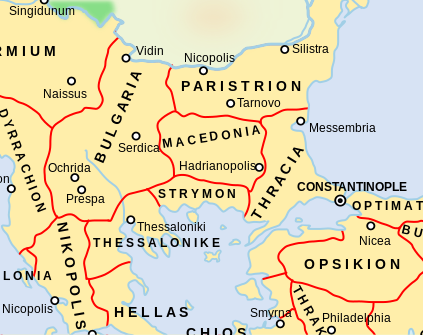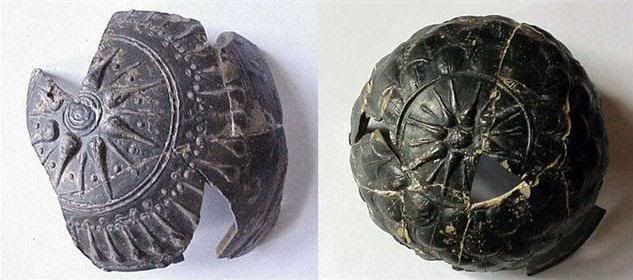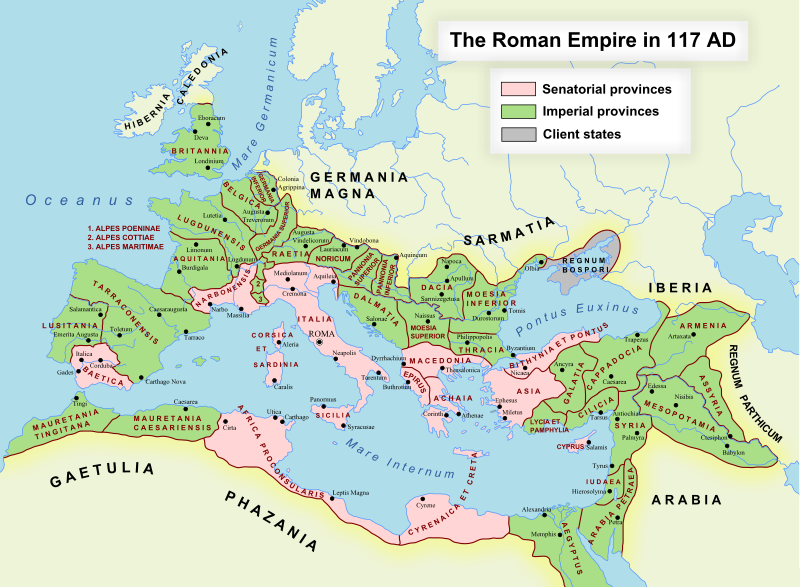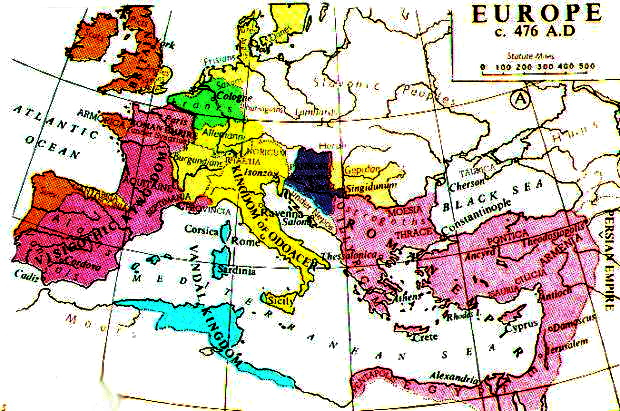Tsar Samuel, Bulgarian or Macedonian? (Armenian?)
http://www.utexas.edu/cola/centers/lrc/blog/samuel.html
Todd B. Krause
An issue that frequently arises in connection with the LRC's lesson series
Old Church Slavonic Online is the national or cultural or other affiliation of the famous Tsar Samuel (or Samuil, or somewhat more faithfully
Samoilŭ). In the context of the lesson series,
Samuel is mentioned as author of a particular inscription that provides the oldest dated text in the Old Church Slavonic language. To be clear: that is the
only reason for Samuel's mention in the lesson series, which concerns itself primarily with the
language of a particular region and time.
Nevertheless, the series editors have on numerous occasions been reminded by readers that Samuil's status as a prominant early figure in Bulgarian and Macedonian history is a great source of either pride or animosity. We would like to state flatly that
the Linguistics Research Center does not espouse any particular viewpoint re: Samuil's association with any modern or historically recent political entity.
There are several themes that recur in email that our readers send us, and in the spirit of furthering modern understanding of historical cultures it is worth addressing some of these themes in light of modern scholarship.
- Samuil's ethnic origin: The perennial question is whether Samuil was Bulgarian or Macedonian. The simple fact is that it is difficult to answer this question, because what those terms mean now is not necessarily what they would have meant to Samuil. Moreover, one of the few primary sources in any way contemporary with Samuil, written by Asolik, states that Samuil was in fact Armenian. As Adontz (1938) points out, the name of Samuil's mother, Ripsime, is peculiar to a specific region in Armenia, and his father's name Nicolas is found in numerous regions at that time, among them Armenia. Thus an Armenian origin for Samuil is certainly a credible, though perhaps not the only, reading of the evidence presented to date.
- Samuil's cultural self-identification: As many point out, what we in the modern era think about Samuil's cultural affiliation is moot if we know what he thought of himself. Unfortunately, that's not easy to determine. Though Samuil and later members of his family used, in reference to their cultural affiliation, terms we might now render as "Bulgarian," given the political climate and power struggles of his time it is quite difficult to ascertain to what degree this term truly specified a traditional culture, or to what degree it might rather have specified a political entity defining the empire. It is quite possible that "Bulgarian" meant to Samuil something similar to what "Roman" likely meant to Charlemagne, who neither lived in nor hailed from Rome.
- General import: The above points hopefully provide an inkling of the grave difficulties that surround the interpretation of the small amount of information we have concerning Samuil. Certainly there is room for continued refinement in our understanding. But we would do well to keep in mind points raised by Aleksandar Panev:
"The differences in the various historical accounts of Samuel, who ruled a short-lived kingdom centered in Prespa and Ohrid from 976 to 1014, reflect recent nationalistic controversies and scholarly discourses that have emerged in the scholarly literature of modern Macedonia and Bulgaria. The dispute focuses on Samuel's ethnic affiliation and the alleged nationality of his subjects. On one hand, scholars from the
Republic of Macedonia tend to emphasize the cultural, social, and even linguistic distinctiveness of Samuel's kingdom. On the other,
Bulgarian scholars emphasize the fact that Samuel used the Bulgarian name for himself and his kingdom and the beginnings of his career in southwestern Macedonia are rarely mentioned. Both approaches clearly aim to support present-day nationalistic claims and agendas. The Macedonians need this approach in order to demonstrate that they have long been a separate nationality with their own language and history; the Bulgarian interpretation, on the other hand, supports the claim that Macedonians are essentially Bulgarians by ethnic origin, as well as by cultural and linguistic characteristics. Both approaches are anachronistic. It is indeed difficult to speak about the national consciousness of a short-lived medieval ruler and his subjects and to discuss his impact on national development at a time when the majority of the population was illiterate and boundaries were fluid. Moreover,
the only primary source that discusses the ethnic affiliation of Samuel asserts that he was an Armenian by origin. Bulgarian and Macedonian ethnic groups only began to acquire national consciousness in the nineteenth and early twentieth centuries. Only during the past century and a half have Southeastern European Slavs gradually begun to assert their nationality and unify around several urban centers. Thus, the national affiliation of Samuel can neither be determined nor could it be relevant to today's situation in the region." (Panev, 2005)
 Themes in the Byzantine Empire under Basil II
http://en.wikipedia.org/wiki/Samuel_of_Bulgaria
http://www.macedonianspark.com/en/hi...11-09-11-46-06
As we can see, King Dusan proclaimed himself for Macedonian king, but not because he was Macedonian, but for someone to proclaim himself a king, or emperor in medieval times had to take the crown of a kingdom that existed previously. And what kingdom would that be if not the kingdom of Samuel!
Themes in the Byzantine Empire under Basil II
http://en.wikipedia.org/wiki/Samuel_of_Bulgaria
http://www.macedonianspark.com/en/hi...11-09-11-46-06
As we can see, King Dusan proclaimed himself for Macedonian king, but not because he was Macedonian, but for someone to proclaim himself a king, or emperor in medieval times had to take the crown of a kingdom that existed previously. And what kingdom would that be if not the kingdom of Samuel! Knowing that Kosara, daughter of Samuel married DuklaPrince John Vladimir, who was a prisoner at Samuil's royal palace. However, lucky for him, thanks to the love of Kosara, he was pardoned and became son in-law of Samuel, but also part of the family.
Is there any greater evidence that would challenge the contention of some Bulgarian historians that Samuil’s state was Bulgarian? According to medieval law, the king's crown could be obtained only from the patriarch. When Emperor Dusan governed the whole territory of Macedonia in his state was found two autocephalous Archbishopry, the one of Ohrid and Pech. Soon Dusan decided to proclaim himself a king. Therefore it was necessary the Pech archdiocese to be declared for patriarchate. It was helped by the Ohrid Archbishop and the TrnovoPatriarch. The both Holy Synods and the Patriarch of Trnovo came, and both of them proclaimed Joannicius II for patriarch, and then the three church dignitaries coronate Dusan in a king. The participation of the Macedonian superior - Ohrid Archbishop was considered as a substitute for the Ecumenical Patriarch, who canceled his attendance in the coronation. Any changes in the Serbian state and church were done with the participation and the blessing of the Macedonian archbishop.
Whether in this case we should close our eyes when the same Macedonian church today is denied?
This historical fact, in the 19th century disturbed the Serbian intelligence, which was in its infancy, that’s why there are many falsifications of the Serbian medieval documents in their re-publishing in the 19th century.
Cups found in Samuils Fortress
http://en.wikipedia.org/wiki/Samuil's_Fortress,_Ohrid

.jpg) http://www.mav.mk/article.php?lang=en&article=14
Samuil’s Fortress (Pasko Kuzman)
http://www.mav.mk/article.php?lang=en&article=14
Samuil’s Fortress (Pasko Kuzman)
Relief (megharic) ceramic cups with representation of the solar symbol of the ancient Macedonians (2nd century BC), discovered in the same cistern.
http://en.wikipedia.org/wiki/Vergina_Sun
Bulgarian Falsification of Macedonian history
The stone inscriptions case
http://www.makedonika.org/whatsnew/THE%20STONE%20INSCRIPTIONS%20CASE.pdf
1. This is the fabricated stone inscription by "Tsar Samuil" found in Voden (Edessa), Greece.
2. This is the stone inscription by Ivan Vladislav found in Bitola, Macedonia.
THE TEXT
1. This is the text translated in Bulgarian from the fake stone in Voden:
1. V samodurjavnia grad Voden Az Samuil, veren v Hrista
2. Car na Bulgarite i Romeite, ot boga izpraten samodurjec
3. na vsichki strani ot Rashka do Makedonia, Tesalia
4. i Gurcia , vnuk na staria Shishman, koito beshe Han na
5. jitelite na Turnovo, postroih tozi molitven dom, za da
sushtestvuva v vechnostta. Osnovite biaha polojeni v epohata
na Ieremia, koito beshe pruv hristianin ot Melnik.
6. Postroen be (tozi hram) za grehovete i spasenieto na bulgarite
7. ot prokletia Satana, koito proizhojda ot Konstantinopol.
8. Tozi hram be zavurshen prez 14-tata godina ot caruvaneto mi
s pomoshtta na sveshtennika Gavril, koito e duhoven pastirna jitelite na Muglen.
9. Napisano prez godina 6497 ot suzdavaneto na sveta (989 g.)5-ti Indiktion.
Rough translation into English:
In the city of Voden, I Samuil, faithul to Christ, Emperor of the Bulgars and Romans, Godsent emperor of all lands from Raska to Macedonia, Thessaly and Greece, nephew of the old Shishman who was Khan of the inhabitants of Trnovo, built this prayer home, to exist forever. The foundation were laid in the epoch of Jeremiah, who was the first hristian in Melnik. This tample was built for the sins and saving of the Bulgars from damned Satan, who comes from Constantinople. This tample was finished during the 14th year of my rule with the help of monk Gavril, who is the spiritial shepherd of the inhabitants of Meglen. Written during year 6497 from the foundation of the world (989 A.D), 5th Indiction.
2. This is the text translated in Bulgarian from the stone in Bitola:
"Prez godina 6523 (1015-1016) ot sutvorenieto na sveta obnovi se tazi krepost, zidana i pravena ot Ioan, samodurjec bulgarski, s pomoshtta i s molitvite na presvetata vladichica nasha Bogorodica i chrez zastupnichestvoto na dvanadesette i na vurhovnite apostoli. Tazi krepost be napravena za ubejishte i za spasenie i za jivota na bulgarite. Zapochnata beshe krepostta Bitolia prez mesec oktomvri v 20-i den, a se zavurshi v mesec... kraia. Tozi samodurjec beshe bulgarin po rod, vnuk na Nikola i na Ripsimia blagovernite, sin na Aaron, koito e brat na Samuil, caria samodurjaven, i koiito dvamata razbiha v
Shtipon (Ihtiman) gruckata voiska na car Vasilii, kudeto be vzeto zlato... , a tozi v... car razbit bide ot car Vasilii v godina 6522 (1014) ot sutvorenieto na sveta v Kliuch i pochina v kraia na liatoto."
Rough translation into English:
During the year 6523 (1015-1016) from the beggining of the world this fortress is being renewed, built and made by Ioan, Bulgarian autocrator, with the help and prayers of our Virgin Mary and through the representation of the twelve and supreme apostles. This fortress was made as haven and deliverance of the lives of the Bulgarians. The fortress Bitolia was started during the month of October 20th and was completed in the month of... ending. This autocrator was Bulgarian by birth, nephew of Nikola and Ripsimia, son of Aaron, who is brother to Samuil, the tsar autocrator, with whom they smashed in Shtipon (Ihtiman) the Greek army of tsar Vasili, where they took gold..., and this tsar was destroyed by tsar Vasili in the year of 6522 (1014) from the beginning of the world in Kliuch and died at the end of the summer
3. The Story
During September 1997 a Greek national with "Bulgarian identity" from Voden named Stoidis
appeared in Sofia at the National Historical Museum and declared to the Director Bozidar
Dimitrov that he has in his possession a stone inscription found in Voden (Edessa) during
the reconstruction of a local church. The Director declared the inscription a fake made
by Bulgarian nationalists in the 19th Century. Apparently the whole story was published
in the Bulgarian daily Kontinent on "02.10.1997."
The "Bitola inscription" was discovered during the demolition of a mosque in Bitola during the
1950's and so far nobody doubted its veracity. Considering the Voden case the Bitola stone
has to be viewed in new light. Chances that it was written by the same authors are indeed very
high. We have also to ask about other products from the same authors as well as regard
the whole Bulgarian historiography concerning Macedonia with great suspicion.
The legend of Basil the Bulgar-slayer.
http://www.deremilitari.org/REVIEWS/Stephenson_basil.htm
In chapter five, Stephenson explores how the contemporary authors referred to Basil.
An extensive survey of the Byzantine sources reveal that instead of Voulgaroktonos, Basil was generally referred to as porphyrogennetos or "born in the purple" to show he was the reigning emperor. Otherwise he was referred to as "the younger" or "the second". Thus Basil was known to the chroniclers and others as Basil II. This trend continued in the literature well beyond the life of Basil. Stephenson also reveals that this was well known even to biographers in the seventeenth century.
It is not until chapter six that
the mystery is revealed in why Basil transforms from porphyrogennetos into the Voulgaroktonos. As one might suspect it has more to do with political changes, particularly in the ways that Bulgars were viewed in the twelfth century, rather than any particular historical activities. However, Basil image would decline again in later centuries, particularly with the rise of the Turks and a decline in the threat from the Bulgars.








.jpg)








